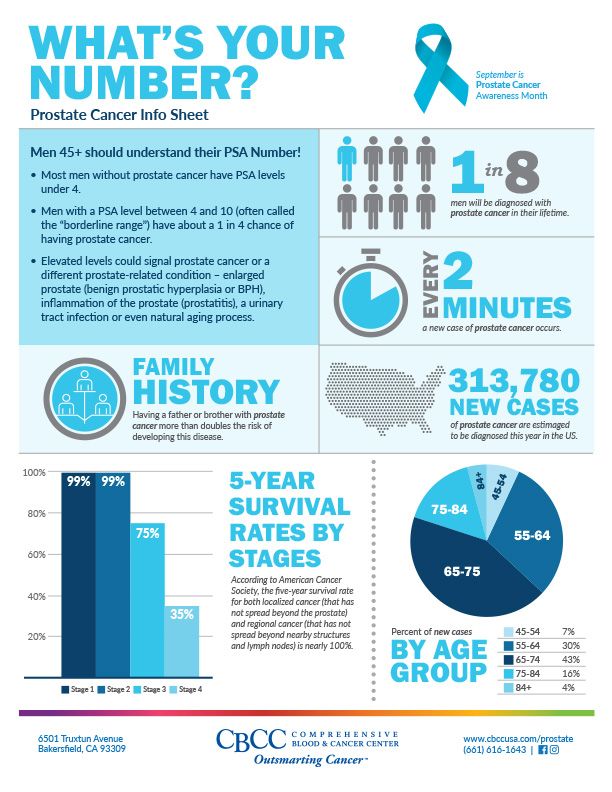What’s My Number?
Men 45+ should know their PSA Number!
Call (661) 322-2206 to schedule a PSA Blood Test offered FREE at CBCC this September.


Prostate Cancer Screening
Prostate cancer is the second most common cancer in men. A man is more likely to develop prostate cancer than he is to develop colon, kidney, melanoma, and stomach cancers combined. As men get older, the risk of developing prostate cancer increases exponentially. Prostate cancer can be silent — it’s important to get checked, even if you have no symptoms. Prostate cancer is the second leading cause of cancer death in American men, with 1 man in 41 succumbing to prostate cancer.
Signs and Symptoms of Prostate Cancer
Symptoms of Prostate Cancer can be similar to other health problems, so if you have any of these symptoms, it’s important to check with your doctor.
- Frequent urination or urge to urinate
- Low or interrupted urine flow
- Blood in the urine
- New onset erectile dysfunction
- Discomfort when sitting
- Pain in bones and joints
- Swelling in legs
- Fatigue
- Change in bowel habits

Prostate Cancer Screening
Recent research has shown that deaths from prostate cancer have decreased by 30% since the PSA test became available. Early diagnosis can help catch the cancer before it becomes life-threatening or causes serious symptoms.
CBCC provides complementary prostate cancer screenings such as PSA blood tests for men 45+ during the month of September, National Prostate Cancer Awareness Month.
PSA Blood Test
Prostate-specific antigen (PSA) is a protein made by cells in the prostate gland. PSA is mostly found in semen, but a small amount is also found in blood. The PSA level in blood is measured in nanograms per milliliter. The higher the PSA, the higher the risk of prostate cancer. Most men without prostate cancer have PSA levels under 4 ng/mL. When prostate cancer develops, the PSA level often goes above 4. Men with a PSA level between 4 and 10 have about a 1 in 4 chance of having prostate cancer. If the PSA is more than 10, the chance of having prostate cancer is over 50%. If your PSA level is high, you might need further testing. There are also certain factors that contribute to a lower or higher PSA count.
Digital Rectal Exam (DRE)
A digital rectal exam is a physical exam by a doctor to check for any abnormalities in the prostate. The prostate is located just in front of the rectum. A doctor inserts a gloved, lubricated finger into the rectum to feel for any bumps or hard areas on the prostate that might be cancer. Prostate cancers often begin in the back part of the gland, and can sometimes be felt during a rectal exam. This exam can be uncomfortable (especially for men who have hemorrhoids), but it usually isn’t painful and only takes a short time.
Other Tests
Additional testing can include special types of PSA tests, such as the Prostate Health Index (PHI), or percent-free PSA test, in addition to other lab tests using blood, urine or semen. Imaging equipment can also be used to map the prostate gland, such as MRI or transrectal ultrasound.
Prostate Biopsy
If PSA levels are high or if a doctor detects or suspects a possible tumor, it may be necessary to perform a biopsy to test the tissue for cancer. A small sample of the prostate is removed and studied under a microscope. This is the only way to know for sure if a man has prostate cancer. If prostate cancer is found on a biopsy, this test can also help tell how likely it is that the cancer will grow and spread quickly.
Prostate Cancer Risk Factors
One in eight men in the U.S. will develop prostate cancer. The risk is greater for certain populations. Researchers have found several factors that might affect a man’s risk of getting prostate cancer.
Age
About 6 in 10 cases are found in men over the age of 65. Prostate cancer is rare in men younger than 40, but the chance of having prostate cancer rises rapidly after age 50.
Race/Ethnicity
Prostate cancer develops more often in African American men and in Caribbean men of African ancestry than in men of other races. And when it does develop in these men, they tend to be younger. Prostate cancer occurs less often in Asian American and Hispanic/Latino men than in non-Hispanic whites. The reasons for these racial and ethnic differences are not clear.
Geography
Prostate cancer is most common in North America, northwestern Europe, Australia, and on Caribbean islands. It is less common in Asia, Africa, Central America, and South America. The reasons for this are not clear.
Family History
If your relatives have a history of prostate cancer, you may be twice as likely to develop the disease. Prostate cancer seems to run in some families. Having a father or brother with prostate cancer more than doubles a man’s risk of developing this disease. The risk is much higher for men with several affected relatives.
Other Factors
Some factors have a less clear effect on prostate cancer risk such as diet and obesity.
Some studies have suggested that men who eat a lot of dairy products appear to have a slightly higher chance of getting prostate cancer. Some studies have found that obese men have a lower risk of getting a low-grade (slower growing) form of the disease, but a higher risk of getting more aggressive (faster growing) prostate cancer. The reasons for this are not clear.
